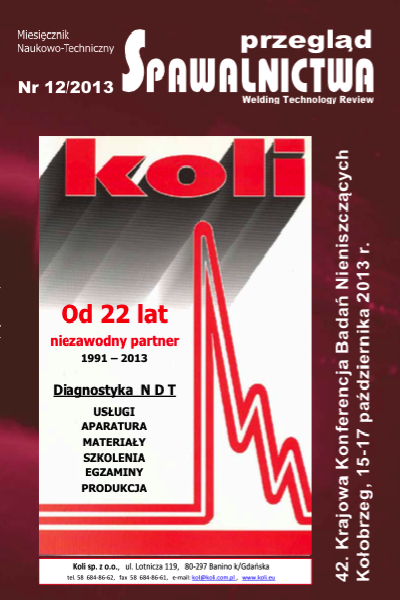NDT and SHM for fatigue and fracture mechanical property determination
Main Article Content
Abstract
Plant components in power plants like nuclear power plants (NPP) and chemical plants like refineries are very often manufactured in austenitic stainless steel because of the resistance of the material against corrosion. However, the components are very often under elevated service tem- peratures in the 280°Ã·300°C regime and under mechanical cyclic deformation. The components so far designed with sufficient fracture toughness fail by fatigue crack initiation, crack growth to local leak and normally not break. When the cyclic deformation is in the LCF (low-cycle- fatigue, some thousand load cycles till end of life) regime the cracking is due surface-breaking cracks. nDT technology most applied is MT, i.e. magnetic testing as magnetic particle inspection based on the magnetic leakage fields of the surface cracks. So far the components are not ferromagnetic; PT (penetrant testing) is well introduced. In the nuclear field, because of the reason of contamination of the inspection media very often in the last years eddy current inspection (ET) was introduced and qualified. However, worldwide there is the strategy to life extent the nuclear power plants, and therefore in the last decade R&D to nDT for nuclear safety has concentrated to develop material characterization techniques for early detection of ageing phenomena [1]. The objective is to detect and quantify ageing in the material microstructure before a macroscopic crack occurs. These techniques were applied to monitor the fatigue behavior in the laboratory at servo-hydraulic machines. The next step is planned to implement the technology into lifetime management strategies of nPP to monitor components, i.e. pipes like the surge line or spray lines. The developed techniques also have a high potential to monitor fracture mechanical tests which normally are very time-consuming. First approaches are discussed in the here presented contribution. By using UT and time-of-flight of the surface-acoustic wave (Rayleigh wave) the crack-initiation at a fracture mechanical test specimen can be detected.
Streszczenie
Elementy elektrowni jądrowych i fabryk chemicznych, np. rafinerii, są wykonywane z wysokostopowych stali austenitycznych ze względu na dużą odporność na korozję. Jednak elementy często pracują w temperaturze powyżej dopuszczalnej wynoszącej 280÷3000C i podda- wane są cyklicznym deformacjom. Elementy zaprojektowane tak by, miały odpowiednią odporność na pęknięcia, ulegają zniszczeniu w wyniku rozwoju lokalnej wady. W przypadku gdy cykliczne deformacje znajdują się w przedziale LCF (małe cykliczne zmęczenia, wynoszące kilka tysięcy cykli w całym okresie pracy), nie występują groźne złamania. Ze względu na to, że stal austenityczna nie jest ferromagnetyczna, nie jest możliwe wykorzystanie metody strumienia rozproszonego. Do wykrywania wad powierzchniowych używana jest metoda penetracyjna. W elektrowniach jądrowych używana jest metoda prądów wirowych. Obecnie podejmowane są wysiłki mające na celu wydłużenie czasu pracy elektrowni jądrowych. Z tego powodu rozwijane są metody wczesnego wykrywania starzenia się materiału [1]. Celem jest wykrycie i ilościowa ocena starzenia przed powstaniem wady. Umożliwiają one wczesną ocenę stopnia starzenia się materiału. W pierwszym kroku te metody są używane w laboratorium. następnie zostaną one wykorzystane w badaniach przemysłowych, w szczególności w badaniu starzenia się rurociągów. Rozwijane metody są bardzo użyteczne w testowaniu pęknięć, bez użycia ich proces jest bardzo czasochłonny. W obecnej pracy jest opisana faza laboratoryjna. Posługując się metodą ultradźwiękową, można wykryć wadę we wczesnej fazie. Metoda powinna być testowana i oceniana ilościowo. Czas testowania zostanie wyraźnie skrócony. Przewiduje się dalsze badania. Obecnie w tym celu używany jest specjalnie skonstruowany tester ultradźwiękowy EMAT.
Downloads
Article Details
Creative Commons CC BY 4.0 https://creativecommons.org/licenses/by/4.0/
Welding Technology Review (WTR) articles are published open access under a CC BY licence (Creative Commons Attribution 4.0 International licence). The CC BY licence is the most open licence available and considered the industry 'gold standard' for open access; it is also preferred by many funders. This licence allows readers to copy and redistribute the material in any medium or format, and to alter, transform, or build upon the material, including for commercial use, providing the original author is credited.
References
G. Dobmann: non-destructive Testing for Ageing Manage- ment of nuclear Components, nuclear Power - Control, Reliability and Human Factors, 2011, ISBn: 978-953-307-599-0
H.-J. Salzburger: EMATs and its Potential for Modern NDE - State of the Art and Latest Applications, Proceedings of the IEEE International Ultrasonics Symposium 1, 2009, 621-628
H.-J. Salzburger, F. niese, and G. Dobmann: EMAT pipe inspection with guided waves, Welding in the world 56 (2012), 5-6
H.-J.Bassler:Cyclicdeformationbehaviorandstrain-induced development of martensite in case of the austenitic stainless steel X 6 CrniTi 18 10 (in German), Ph.D.-thesis at the Univer- sity Kaiserslautern, 1999
M. Lang: non-destructive characterization of the cyclic defor- mation behavior and the development of strain-induced mar- tensite in case of the austenitic stainless steel X6 CrniTi 1810 by use of sensitive magnetic sensors (in German), Ph.D.- thesis at the University of the Saarland, Saarbrücken, 2000
I. Altpeteretal:Earlydetectionofdamageinthermo-cyclical- ly loaded austenitic materials, EnDE 2011 proceedings, ISO press, EnDE 2011 conference, March 10-12, Chennai
German patent DE 3820475: Magnetfeldsensor mit ferromagnetischer, dünner Schicht,filed on 16.06.1988
A. Yashan,: To eddy current (EC) and magnetic leakage flux (ET) testing with GMR sensors (in German), Ph.D.thesis at the Saar university, Saarbrücken, 2008
ESISP2-92,Procedurefordeterminingthefracturetoughness of materials, European Structural Integrity Society (1992)
ESIS P6-98, Procedure to measure and calculate material
parameters for the local approach to fracture using notched tensile specimens, European Structural Integrity Society. Ed. K.-H. Schwalbe, GKSS Geeshacht (1998)
ASTM E 399-90, Standard test method for plane-strain frac- ture toughness of metallic materials, Annual Book of ASTM Standards Vol. 03.01, American Society for Testing and Materials (1997)
ASTM E 1737-96, Standard test method for J-integral charac- terization of fracture toughness, Annual Book of ASTM Standards Vol. 03.01, American Society for Testing and Materials (1997)
ASTM E 1820-96, Standard test method for measurement of fracture toughness, Annual Book of ASTM Standards Vol. 03.01, American Society for Testing and Materials (1997).
